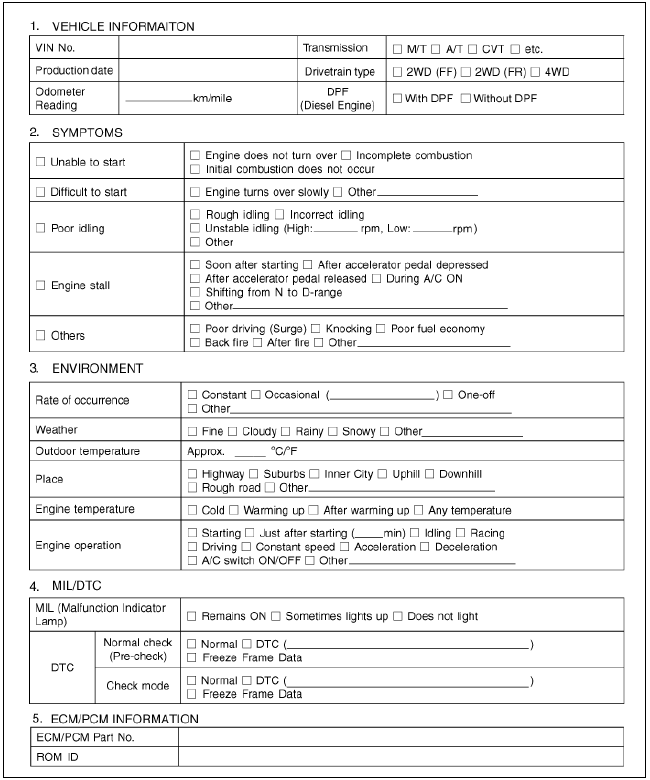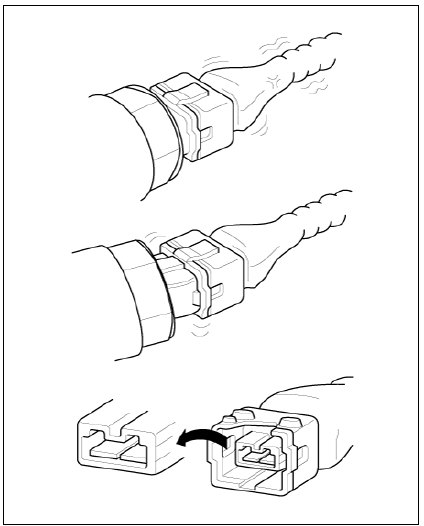KIA Niro: Basic Troubleshooting
Basic Troubleshooting Guide

Customer Problem Analysis Sheet

Basic Inspection Procedure
Measuring Condition of Electronic Parts' Resistance
The measured resistance at high temperature after vehicle running may be high or low. So all resistance must be measured at ambient temperature (20ºC, 68ºF), unless stated otherwise.
Warning
The measured resistance except at ambient temperature (20ºC, 68ºF) is the reference value.
Intermittent Problem Inspection Procedure
Sometimes the most difficult case in Troubleshooting is when a problem symptom occurs but does not reoccur during test. An example would be if a problem appears only when the vehicle is cold but has not appeared when warm. In this case, the technician should thoroughly make out a "Customer Problem Analysis Sheet" and recreate (simulate) the environment and condition in which the vehicle was having the issue.
- Clear Diagnostic Trouble Code (DTC).
- Inspect all connections, check terminal for poor connections, loose wires, bent, broken or corroded pins, and then verify that the connectors are securely fastened at all times.

- Lightly shake the connector and wiring harness vertically and horizontally.
- Repair or replace the component with a problem.
- Perform road test to verify that the problem has disappeared.
Simulating Vibration
- Sensors and Actuators
Lightly shake sensors, actuators or relays by finger.
Warning
Strong vibration may break sensors, actuators or relays.
- Connectors and Harness
Lightly shake the connector and wiring harness vertically and then horizontally.
Simulating Heat
- Heat components suspected of causing the malfunction with a hair dryer or other heat source.
Warning
- DO NOT heat components to the point of damaging them.
- DO NOT heat the ECM directly.
Simulating Water Sprinkling
- Sprinkle water onto vehicle to simulate a rainy day or a high humidity condition.
Warning
DO NOT sprinkle water directly onto the engine compartment or electronic components.
Simulating Electrical Load
- Turn on all electrical systems to simulate an excessive electrical load (Radios, fans, lights, rear window defogger, etc.).
READ NEXT:
 Connector Inspection Procedure
Connector Inspection Procedure
Handling of Connector
Never pull on the wiring harness when
disconnecting connectors.
When removing the connector with a latch, press or
pull locking lever.
Listen for a click when locking connectors. This
 Electrical Circuit Inspection Procedure
Electrical Circuit Inspection Procedure
Open Circuit Test
Procedures for Open Circuit
Continuity Check
Voltage Check
If an open circuit occurs (as seen in (FIG. 1)), it can be found by
performing Step 2 (Continuity Check Method) or Step 3
(Voltage Check Method) as shown b
 Engine Control System
Engine Control System
Components
Location
Engine Control Module (ECM)
Manifold Absolute Pressure Sensor (MAPS)
Mass Air Flow Sensor (MAFS)
Intake Air Temperature Sensor (IATS)
Engine Coolant Temperature Sensor (ECTS) (Water Temperature Control
Assem
SEE MORE:
 Multimedia Jack
Multimedia Jack
Circuit Diagram
Description
The multimedia jack on the console upper cover is for customers who like to
listen to external portable music players like the
MP3 etc., through the vehicle's sound system when it is linked to this jack. The
 Defrosting/defogging windshield
Defrosting/defogging windshield
Defrosting/defogging windshield (Kia NIRO Hybrid)
Defrosting/defogging windshield
(Kia Niro EV)
Operation
Set the fan speed to the desired position.
Select desired temperature.
Select ( ) or (
).
The outside (fresh) air and ai
Categories
- Home
- KIA Niro EV, Hybrid - Second generation - (SG2) (2021-2024) - Owner's manual
- Kia Niro - First generation - (DE) (2017-2022) - Service and Repair Manual
- Contact Us
